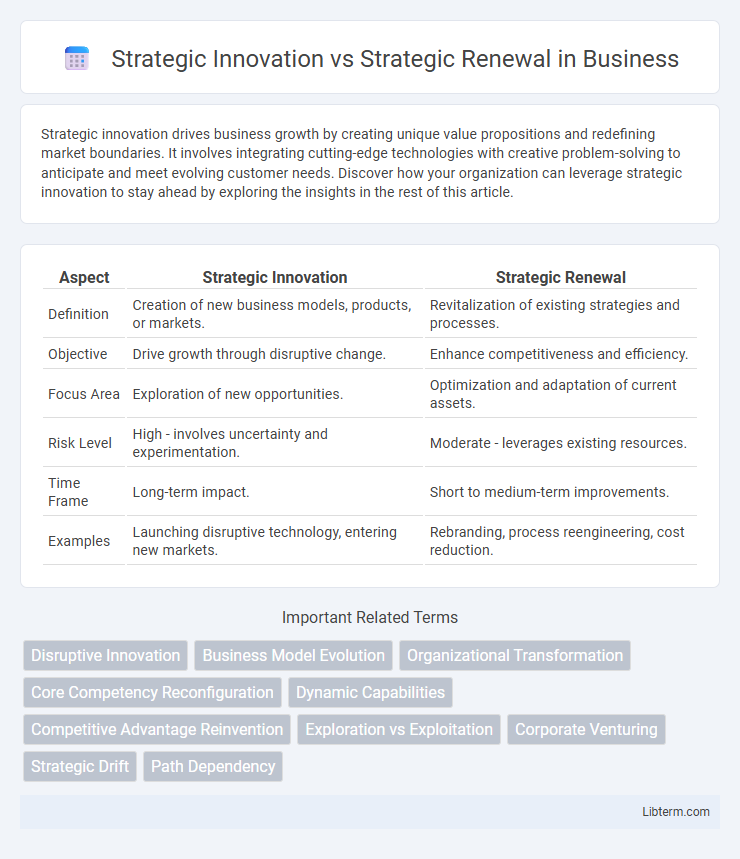Strategic innovation drives business growth by creating unique value propositions and redefining market boundaries. It involves integrating cutting-edge technologies with creative problem-solving to anticipate and meet evolving customer needs. Discover how your organization can leverage strategic innovation to stay ahead by exploring the insights in the rest of this article.
Table of Comparison
| Aspect | Strategic Innovation | Strategic Renewal |
|---|---|---|
| Definition | Creation of new business models, products, or markets. | Revitalization of existing strategies and processes. |
| Objective | Drive growth through disruptive change. | Enhance competitiveness and efficiency. |
| Focus Area | Exploration of new opportunities. | Optimization and adaptation of current assets. |
| Risk Level | High - involves uncertainty and experimentation. | Moderate - leverages existing resources. |
| Time Frame | Long-term impact. | Short to medium-term improvements. |
| Examples | Launching disruptive technology, entering new markets. | Rebranding, process reengineering, cost reduction. |
Understanding Strategic Innovation
Strategic innovation involves creating new value propositions and business models that disrupt existing markets or establish entirely new ones, emphasizing breakthrough thinking and customer-centric solutions. It requires organizations to leverage emerging technologies, market insights, and creative problem-solving to gain a competitive advantage and drive long-term growth. Understanding strategic innovation centers on recognizing opportunities for transformation rather than incremental improvement, aligning resources to pioneer novel strategies that reshape industry landscapes.
Defining Strategic Renewal
Strategic renewal involves redefining an organization's core capabilities and business models to adapt to evolving market conditions and sustain long-term competitiveness. Unlike strategic innovation, which focuses on creating breakthrough products or services, strategic renewal requires revitalizing existing resources and processes to respond dynamically to environmental changes. This process enables firms to overcome stagnation and drive continuous growth by realigning their strategic direction without abandoning foundational strengths.
Key Differences Between Strategic Innovation and Strategic Renewal
Strategic innovation centers on creating new business models, products, or services that disrupt existing markets, while strategic renewal focuses on refreshing and improving current capabilities to sustain competitiveness. Innovation drives growth through breakthrough changes, whereas renewal emphasizes adaptation by refining organizational processes and structures. The key difference lies in innovation's pursuit of novelty versus renewal's objective of revitalizing existing strategies.
Importance of Strategic Innovation in Modern Business
Strategic innovation drives competitive advantage by enabling businesses to develop groundbreaking products, services, and business models that meet evolving market demands and disrupt industries. It fosters adaptability and long-term growth in dynamic environments, surpassing the incremental improvements of strategic renewal. Emphasizing strategic innovation helps companies respond proactively to technological advancements and shifting consumer preferences, ensuring sustained relevance and market leadership.
Role of Strategic Renewal in Sustaining Competitive Advantage
Strategic renewal plays a critical role in sustaining competitive advantage by continuously adapting and revitalizing an organization's resources, capabilities, and business models to address evolving market conditions and technological changes. Unlike strategic innovation, which primarily focuses on introducing breakthrough products or services, strategic renewal emphasizes the systematic transformation of existing strategies and structures to enhance long-term organizational resilience and performance. Effective strategic renewal enables firms to overcome inertia, avoid strategic myopia, and maintain relevance in highly dynamic industries, thereby securing a sustainable competitive edge.
Approaches to Implementing Strategic Innovation
Strategic innovation emphasizes pioneering new business models, products, or markets through design thinking, cross-functional collaboration, and agile methodologies to drive competitive advantage. Organizations implement strategic innovation by fostering a culture of experimentation, leveraging digital technologies, and engaging customers in co-creation processes to rapidly prototype and scale breakthroughs. This approach contrasts with strategic renewal, which focuses on revitalizing existing operations through continuous improvement and adaptive change management.
Effective Strategies for Driving Strategic Renewal
Effective strategies for driving strategic renewal emphasize continuous learning, adaptive leadership, and fostering a culture of innovation within organizations. Implementing iterative processes such as agile project management and leveraging data-driven decision-making enables companies to respond swiftly to market changes. Investing in talent development and promoting cross-functional collaboration accelerates the renewal of core capabilities and business models.
Challenges in Balancing Innovation and Renewal
Balancing strategic innovation and strategic renewal presents challenges such as resource allocation conflicts and shifting organizational priorities, where innovative initiatives may compete with the need to revitalize existing processes. Companies often struggle with cultural resistance to change, as renewal efforts require modifying entrenched systems while innovation demands experimentation and risk-taking. Effective management requires aligning innovation projects with renewal goals to sustain competitive advantage without disrupting core operations.
Case Studies: Success Stories of Innovation and Renewal
Tesla's strategic innovation in electric vehicles transformed the automotive industry by pioneering sustainable technology and reshaping consumer expectations, while IBM's strategic renewal focused on shifting from hardware manufacturing to cloud computing and AI services, enabling long-term relevance in a fast-changing market. Apple exemplifies strategic innovation with the launch of the iPhone, creating a new market paradigm, whereas Netflix demonstrates strategic renewal by transitioning from DVD rentals to leading streaming and content production. These case studies showcase how organizations leverage either innovation or renewal strategies to sustain competitive advantage and drive growth.
Future Trends in Strategic Innovation and Renewal
Strategic innovation emphasizes the creation and implementation of groundbreaking ideas that transform markets, leveraging emerging technologies such as artificial intelligence, blockchain, and sustainability-driven solutions to capture future growth opportunities. Strategic renewal focuses on revitalizing existing capabilities and business models by integrating digital transformation, agile methodologies, and customer-centric approaches to sustain competitive advantage in evolving industries. Future trends indicate a convergence of innovation and renewal efforts where organizations prioritize adaptive ecosystems and continuous learning to navigate disruption and foster long-term resilience.
Strategic Innovation Infographic

 libterm.com
libterm.com